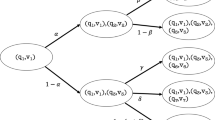Abstract
Expectation propagation is a general approach to fast approximate inference for graphical models. The existing literature treats models separately when it comes to deriving and coding expectation propagation inference algorithms. This comes at the cost of similar, long-winded algebraic steps being repeated and slowing down algorithmic development. We demonstrate how factor graph fragmentization can overcome this impediment. This involves adoption of the message passing on a factor graph approach to expectation propagation and identification of factor graph sub-graphs, which we call fragments, that are common to wide classes of models. Key fragments and their corresponding messages are catalogued which means that their algebra does not need to be repeated. This allows compartmentalization of coding and efficient software development.










Similar content being viewed by others
References
Bishop, C. M. (2006). Pattern Recognition and Machine Learning. New York: Springer.
Carpenter, B., Gelman, A., Hoffman, M. D., Lee, D., Goodrich, B., Betancourt, M., et al. (2017). Stan: A probabilistic programming language. Journal of Statistical Software, 76(1), 1–32.
Gelman, A., Carlin, J. B., Stern, H. S., Dunson, D. B., Vehtari, A., & Rubin, D. B. (2014). Bayesian data analysis (3rd ed.). Boca Raton: CRC Press.
Guo, J., Gabry, J. & Goodrich, B. (2017). The R package rstan: R interface to Stan. R package (version 2.17.2). http://mc-stan.org.
Heese, N., Tarlow, D., & Winn, J. (2013). Learning to pass expectation propagation messages. In C. J. C. Burges, L. Bottou, M. Welling, Z. Ghahramani, & K. Q. Weinberger (Eds.), Advances in neural information processing systems (Vol. 26, pp. 3219–3227). Red Hook: Curran Associates, Incorporated.
Herbrich, R. (2005). Gaussian expectation propagation. https://www.microsoft.com/en-us/research/publication/on-gaussian-expectation-propagation/.
Heskes, T., Opper, M., Wiegerinck, W., Winther, O., & Zoeter, O. (2005). Approximate inference techniques with expectation constraints. Journal of Statistical Mechanics Theory and Experiment, P11015, 1–24.
Heskes, T., & Zoeter, O. (2002). Expectation propagation for approximate inference in dynamic Bayesian networks. In A. Darwiche & N. Friedman (Eds.), Proceedings of the eighteenth annual conference on uncertainty in artificial intelligence (pp. 216–223). San Francisco: Morgan Kaufmann.
Jylänki, P., Vanhatalo, J., & Vehtari, A. (2011). Robust Gaussian process regression with a student-\(t\) likelihood. Journal of Machine Learning Research, 12, 3227–3257.
Kim, A. S. I., & Wand, M. P. (2016). The explicit form of expectation propagation for a simple statistical model. Electronic Journal of Statistics, 10, 550–581.
Kim, A. S. I., & Wand, M. P. (2018). On expectation propagation for generalized, linear and mixed models. A Australian and New Zealand Journal of Statistics, 60, 75–102.
Lienart, T., Teh, Y. W., & Doucet, A. (2015). Expectation particle belief propagation. In C. Cortes, N. D. Lawrence, D. D. Lee, M. Sugiyama, & R. Garnett (Eds.), Advances in neural information processing systems (Vol. 28, pp. 3609–3617). Red Hook: Curran Associates, Incorporated.
McLean, M. W., & Wand, M. P. (2018). Variational message passing for elaborate response regression models. Bayesian Analysis (in press).
Minka, T. (2005). Divergence measures and message passing. Microsoft research technical report series, MSR-TR-2005-173, pp. 1–17.
Minka, T., & Winn, J. (2008). Gates: A graphical notation for mixture models. Microsoft research technical report series, MSR-TR-2008-185, pp. 1–16.
Minka, T. P. (2001). Expectation propagation for approximate Bayesian inference. In J. S. Breese & D. Koller (Eds.), Proceedings of the seventeenth conference on uncertainty in artificial intelligence (pp. 362–369). Burlington: Morgan Kaufmann.
Minka, T., Winn, J. M., Guiver, J. P., Webster, S., Zaykov, Y., Yangel, B., Spengler, A. & Bronskill, J. (2014). Infer.NET 2.6, Microsoft Research Cambridge, 2014. http://research.microsoft.com/infernet.
Murphy, K. (2007). Software for graphical models: a review. International Society for Bayesian Analysis Bulletin, 14, 13–15.
Nolan, T. H., & Wand, M. P. (2017). Accurate logistic variational message passing: Algebraic and numerical details. Stat, 6, 102–112.
Opper, M., & Winther, O. (2000). Gaussian processes for classification: Mean-field algorithms. Neural Computation, 12, 2655–2684.
Opper, M., & Winther, O. (2005). Expectation consistent approximate inference. Journal of Machine Learning Research, 6, 2177–2204.
Ruppert, D., Wand, M. P., & Carroll, R. J. (2009). Semiparametric regression during 2003–2007. Electronic Journal of Statistics, 3, 1193–1256.
Sommer, A. (1982). Nutritional blindness. New York: Oxford University Press.
Thouless, D. J., Anderson, P. W., & Palmer, R. G. (1977). Solution of a “solvable model of a spin glass”. The Philosophical Magazine, 35, 593.
Verdinelli, I., & Wasserman, L. (1991). Bayesian analysis of outlier problems using the Gibbs sampler. Statistics and Computing, 1(2), 105–117.
Wainwright, M. J., & Jordan, M. I. (2008). Graphical models, exponential families, and variational inference. Foundations and Trends in Machine Learning, 1, 1–305.
Wand, M. P. (2017). Fast approximate inference for arbitrarily large semiparametric regression models via message passing (with discussion). Journal of the American Statistical Association, 112, 137–168.
Wand, M. P., & Ripley, B. D. (2015). The R package KernSmooth. Functions for kernel smoothing supporting Wand & Jones (1995) (version 2.23). https://cran.R-project.org.
Wand, M. P., Ormerod, J. T., Padoan, S. A., & Frühwirth, R. (2011). Mean Field Variational Bayes for Elaborate Distributions. Bayesian Analysis, 6(4), 847–900.
Acknowledgements
This research was supported by Australian Research Council Discovery Project DP180100597.
Author information
Authors and Affiliations
Corresponding author
Additional information
Publisher's Note
Springer Nature remains neutral with regard to jurisdictional claims in published maps and institutional affiliations.
Electronic supplementary material
Below is the link to the electronic supplementary material.
Rights and permissions
About this article
Cite this article
Chen, W.Y., Wand, M.P. Factor graph fragmentization of expectation propagation. J. Korean Stat. Soc. 49, 722–756 (2020). https://doi.org/10.1007/s42952-019-00033-9
Received:
Accepted:
Published:
Issue Date:
DOI: https://doi.org/10.1007/s42952-019-00033-9




